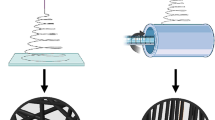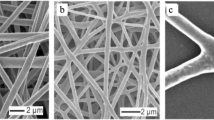Abstract
Compressive properties of electrospun fiber mats are reported for the first time. Mats of bisphenol-A polysulfone (PSU) and of poly(trimethyl hexamethylene terephthalamide) [PA 6(3)T] were electrospun and annealed over a range of temperatures spanning the glass transition temperature of each polymer. The data for applied stress versus mat solidity were found to be well-described by a power law of the form \( \sigma_{\text{zz}} = kE\left( {\phi^{n} - \phi_{0}^{n} } \right) \), where \( \sigma_{\text{zz}} \) is the applied stress and ϕ is solidity, in accord with the analysis of Toll (Polym Eng Sci 38(8):1337, 2004). The values of n range from 3.2 to 6 for PSU and from 8.0 to 20 for PA 6(3)T. The lowest values in each case were exhibited by mats annealed near the glass transition temperature of the fiber material. The values of n are independent of fiber diameter. The higher values of n are attributed to fiber slippage via a mechanism analogous to that of work hardening of metals. The values of kE can vary by an order of magnitude and were difficult to determine precisely, due to the nature of the power law and the inhomogeneity of the mats. The compressibility of electrospun mats in response to an applied stress is sufficiently large that it cannot be neglected in applications where large pressures may be involved, such as filtration or membrane separations. In addition to the initial solidity of the mats, the material compressibility and the operating pressure relevant to the application are important to describe the structure of electrospun mats quantitatively under conditions of use.













Similar content being viewed by others
References
Burger C, Hsiao B, Chu B (2006) Annu Rev Mater Res 36(1):333
Cancedda R, Dozin B, Giannoni P, Quarto R (2003) Matrix Biol 22:81–91
Lowery JL, Datta N, Rutledge GC (2010) Biomaterials 31:491
Luu Y, Kim K, Hsiao B, Chu B, Hadjiargyrou M (2003) J Control Release 89:341
Liu H, Kameoka J, Czaplewski D, Craighead H (2004) Nano Lett 4:671
Chen L, Bromberg L, Lee JA, Zhang H, Schreuder-Gibson H, Gibson P, Walker J, Hammond PT, Hatton TA, Rutledge GC (2010) Chem Mater 22(4):1429
Yoon K, Hsiao B, Chu B (2008) J Mater Chem 18:5326
Huang L, Manickam S, McCutcheon J (2013) J Membr Sci 436:213
Mannarino MM, Rutledge GC (2012) Polymer 56:3017
Van Wyk CM (1946) J Text Inst Trans 37(12):T285–T292
Komori T, Itoh M (1991) Text Res J 61:588
Pan N (1993) Text Res J 63:336
Komori T, Itoh M (1994) Text Res J 64:519
Carnaby GA, Pan N (1989) Text Res J 59:275
Toll S (1998) Polym Eng Sci 38(8):1337
Baudequin M, Ryschenkow G, Roux S (1999) Eur Phys J B 12:157
Dunlop J (1983) J Text Inst 74(2):92–97
Lundquist L, Leterrier F, Manson J (2004) Polym Eng Sci 44(1):45
Kim Y, McCarthy S (1991) Polym Compos 12(1):13
Jaganathan S, Tafreshi HV, Shim E, Pourdeyhimi B (2009) Colloids Surf A 337:173
Eichhorn SJ, Sampson WW (2010) J R Soc Interface 7(45):641
Implementation in MATLAB (R2009a, The Mathworks Inc.) was kindly provided by Dimitrios Tzeranis
Jahne B (2005) Digital image processing. Springer, New York
ASTM Standard D575, 1991 (2012) Standard test methods for rubber properties in compression. ASTM International, West Conshohocken
Li N, Fane A, Ho W, Matsuura T (2008) Wiley, New Jersey, 102, Fig. 5.1
Degarmo P, Black JT, Kohser RA (2003) Materials and processes in manufacturing, 9th edn. Wiley, New Jersey
Acknowledgements
The authors would like to thank the King Fahd University of Petroleum and Minerals (KFUPM) in Dhahran, Saudi Arabia, for funding through the Center for Clean Water and Clean Energy at MIT and KFUPM under PROJECT NUMBER R5-CW-08. We would also like to thank Dr. Zafarullah Khan and Dr. S. M. Javaid Zaidi of KFUPM for many helpful discussions, and the Institute for Soldier Nanotechnology at MIT for use of facilities.
Author information
Authors and Affiliations
Corresponding author
Rights and permissions
About this article
Cite this article
Choong, L.T., Mannarino, M.M., Basu, S. et al. Compressibility of electrospun fiber mats. J Mater Sci 48, 7827–7836 (2013). https://doi.org/10.1007/s10853-013-7528-x
Received:
Accepted:
Published:
Issue Date:
DOI: https://doi.org/10.1007/s10853-013-7528-x




